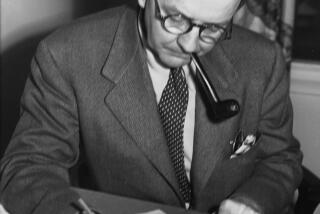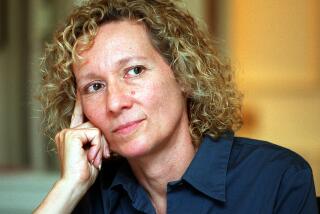George Hitchcock dies at 96; poet and publisher of the literary magazine ‘kayak’
George Hitchcock, a poet, painter and UC Santa Cruz emeritus professor whose iconoclastic vision as publisher of the literary magazine “kayak” helped free American poetry from mid-20th century orthodoxies and provided an early forum for such distinguished writers as Robert Bly, Raymond Carver and Philip Levine, died Friday at his home in Eugene, Ore. He was 96.
His death came after a long illness, said poet Robert McDowell, a former student and longtime friend.
Hitchcock created kayak in 1964 to counter the “tepid eclecticism” that he believed hampered many literary magazines at the time. With its quirky illustrations and preference for surrealist poets, the magazine quickly gained notice as a bulwark on the literary vanguard, where more formal stylists in the modes of such mid-century masters as Robert Lowell and Richard Wilbur were not welcome.
“George was part of that rupturing of this almost neoclassical dam that had stopped American poetry. I would say kayak returned American poetry to its greatest strength, which derives from Whitman — to make it outrageous, to make it, if need be, objectionable,” said Levine, who won the Pulitzer Prize for poetry in 1995, two decades after Hitchcock published what became Levine’s most famous poem, “They Feed They Lion.”
Bly criticized the first 10 issues of kayak in a 1967 essay, asserting that “too much foggy stuff gets in,” but he also called it “valuable, and a much-loved” magazine because of the new voices it promoted. Kayak, he wrote, “would be missed very much if it developed a leak and sank.”
Hitchcock, a former actor, was not widely known for his own poems, although he published more than a dozen volumes. He performed poetry with theatrical gusto and, unlike many poets, was most willing to share the spotlight. Levine, who remembered his surprise when Hitchcock, without warning, called on him at a Fresno reading in 1965, said Hitchcock’s generosity was unique and came from a desire to “make a kind of community of poets in out-of-the-way places or with out-of-the-way aesthetics and maybe even politics.”
Hitchcock taught writing at UC Santa Cruz from 1970 to 1989. In 2002, he created the Hitchcock Poetry Fund, which distributes $20,000 a year to support a variety of programs, including visiting poets, poetry journals and conferences. It also funded the campus’ winning team in the 2004 National Slam Poetry Competition held in St. Louis.
Hitchcock was born June 2, 1914, in Hood River, Ore. His father was a lumber broker; his mother became a reporter for an international news service after the marriage ended in divorce. Hitchcock earned a bachelor’s degree in English at the University of Oregon in 1935 and went into journalism, working for a Eugene newspaper and later for leftist journals, including People’s Daily World. During World War II, he helped build war ships and served in the Merchant Marines. Later he organized dairy workers, taught philosophy at the California Labor School and was an active socialist.
His politics landed him before a subcommittee of the House Un-American Activities Committee in 1957. During the televised hearing, he gained notoriety for his deadpan response to a question about his occupation, which at that time was landscaping. “My profession,” he said, “is a gardener. I do underground work on plants.”
In the mid-1950s he also began writing plays and acting. He landed a number of major roles in productions by the Actor’s Workshop and the Oregon Shakespeare Festival.
In the late 1950s he met Kenneth Rexroth, a central figure in the San Francisco Renaissance movement, who introduced Hitchcock to contemporary poetry. Hitchcock became a co-editor of the San Francisco Review, a literary journal, in 1958 but left in 1963.
The next year he launched kayak and installed himself as sole editor or, as he sometimes described his role, “dictator.” The magazine’s title — the word denoting, as he wrote in every issue, “a small watertight vessel operated by a single oarsman” — reflected the management philosophy of an editor who had come to despair the committee approach to choosing literary submissions.
Kayak flourished for 20 years. It introduced the poetry of such writers as Kathleen Fraser, Margaret Atwood, Charles Simic, Mark Doty and Mark Jarman. Soon, well-known poets, including W.S. Merwin, Hayden Carruth and Anne Sexton, were also appearing in its pages.
To have a poem turned down by Hitchcock was an unusually memorable event because of the form it took. Hitchcock’s rejection letters bore a one-line message, usually stating that the unlucky submission was “not quite what we need this season.” Accompanying the withering text was one of a dozen of his favorite 19th century woodcut illustrations, chosen for their ghastly or ironic effect. They usually showed a man under extreme duress — on the ground with a wolf at his throat, falling through a crack in the ice, or facing an axe-wielding executioner.
The missives “ended up decorating bathroom walls, foyers, kitchens, writing studios. They were laid out on tables at therapy sessions. They provoked grim, hysterical laughter, threats, and tears,” McDowell, who was a student of Hitchcock’s in the early 1970s and later published “One-Man Boat: The George Hitchcock Reader” (2003), wrote in an essay several years ago.
“It was good for a laugh,” Hitchcock once said of the letters, “although some people were terribly insulted. But the ones who are terribly insulted you wouldn’t want in the magazine anyway.”
He is survived by his companion of 38 years, Marjorie Simon; a son, Stephen; and two grandchildren.
elaine.woo@latimes.com
More to Read
Start your day right
Sign up for Essential California for the L.A. Times biggest news, features and recommendations in your inbox six days a week.
You may occasionally receive promotional content from the Los Angeles Times.







